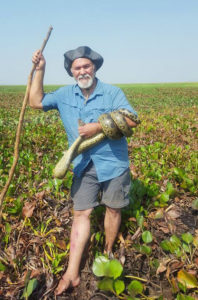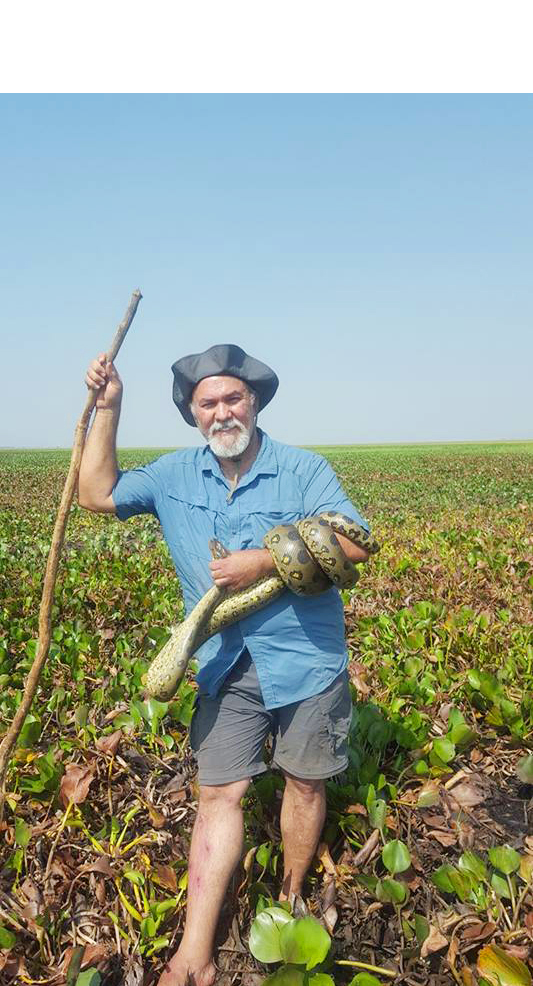May 5, 2020

Highlands University biology professor Jesús Rivas captures a green anaconda during a research expedition in Venezuela in 2017.
Las Vegas, N.M. – New Mexico Highlands University biology professor Jesús Rivas’ book is the first to help nonscience readers explore the life of giant green anaconda snakes in the wild.
In June 2020, Oxford University Press will publish Rivas’ book, Anaconda – The Secret Life of the World’s Largest Snake. His study area is primarily in the Venezuelan Llanos – a vast plain that floods during the wet season from May through October.
“My biggest goal with this book is to convey my experience learning about anacondas and their lives,” Rivas said. “Anacondas are fascinating. I want to share my love of anacondas because people will only protect what they love.
“The more we know about endangered anacondas and their place in the ecosystem, the better the chance we can conserve them,” Rivas said.
The 300-page book features numerous photographs, including ones of Rivas involving Highlands University students in his anaconda field research in Venezuela.
“Jesús Rivas is one of those risk-taking pioneers studying large animals most vulnerable to extinction that are especially valuable in helping us appreciate the lives of charismatic animals before it’s too late,” wrote Gordon Burghardt in the foreword of Rivas’ new book. “This fascinating book gives us deep glimpses into how anacondas live in nature.”
Burghardt, who was Rivas’ Ph.D. adviser at the University of Tennessee, is a professor in both the Ecology and Evolution Department and Psychology Department.
“Rivas is a creative and brilliant field biologist. This new book is a rare treasure for anyone interested in the lives of potentially dangerous animals and the scientists who study them,” Burghardt said.
Rivas is known globally for his anaconda research, which spans 28 years. He is a Venezuelan-born herpetologist – a scientist who studies reptiles and amphibians. Rivas founded the ongoing Anaconda Project in 1992, which focuses on research and conservation.
For three years, Rivas was a field and broadcast correspondent for National Geographic wildlife documentaries. He is also featured in documentaries on the Discovery Channel, the BBC, Animal Planet and the Smithsonian Channel.
“Green anacondas live in swamps in South America and you need to find the animals in their natural habitat to study them. You locate them by walking through miles of swamp. When you find an anaconda, you hold it behind its head and restrain it until it tires. Like all reptiles, anacondas tire quickly,” Rivas said.
Anacondas are nonvenomous snakes that use constriction to kill their prey. In Rivas’ 2000 doctoral dissertation on green anacondas, the largest anaconda weighed 220 pounds and the longest measured 18 feet in length.
“Humans are fascinated by large predators, so anacondas have enjoyed a place of mystery with people who inhabit the same area. They believe anacondas are enchanted and must be protected,” Rivas said
This is Rivas’ second book on anacondas. In 2016, Natural History of the Green Anaconda: With Emphasis on its Reproductive Biology, was published. This book was directed at the scientific community and was based on his doctoral dissertation.
Since joining the Highlands faculty in 2010, Rivas and fellow biology professor Sarah Corey-Rivas have led their students on several research expeditions to South America to study anacondas and other tropical wildlife.
In New Mexico, Rivas and his students study species of concern such as the northern New Mexico leopard frog and snapping turtles.

